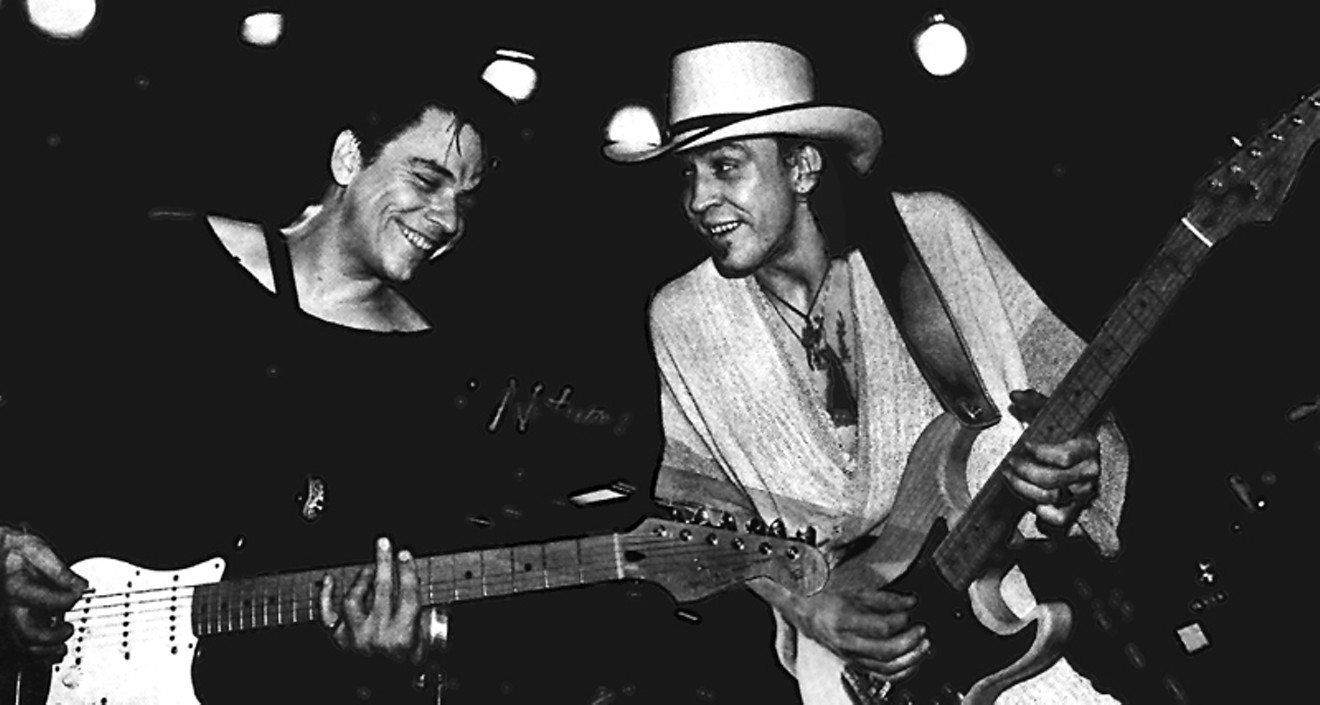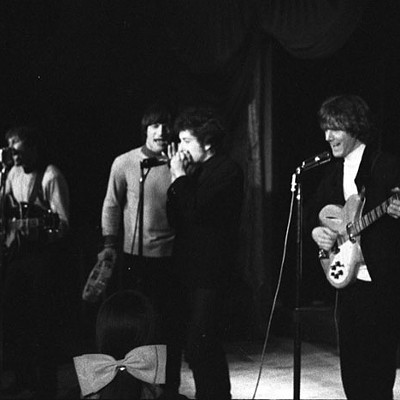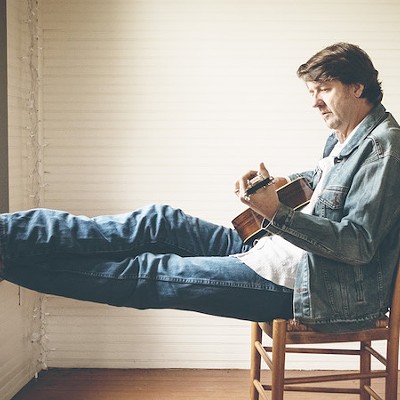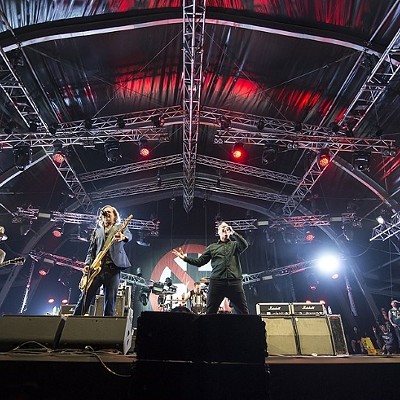It’s a well-worn cliché in music history that Brothers Will Battle. From the Dorsey, Everly and Davies boys to the Fogerty, Robinson and Gallagher lads, sonic siblings often don’t get along.
But maybe that’s because they’re in the same band. Or—just possibly—They’re not from Texas. After all, two of the closest brotherly bonds have been between Johnny and Edgar Winter of Beaumont and Jimmie and Stevie Ray Vaughan of Oak Cliff.
It’s the intertwining tale of the latter duo that is the subject of Jimmie and Stevie Ray Vaughan: Brothers in Blues. The new documentary is written, directed, produced and narrated by longtime Texas music scenester and former editor of Buddy magazine Kirby Warnock.
“You may be onto something with that brothers theory!” Warnock laughs via Zoom from his home. “They tried to be in a band together once in Storm, but it didn’t work out. So, that’s a good way to look at it!”
Using contemporary interviews, archival footage and rare photos, the doc tells the musical and life stories of the brothers both individually and together, up to and past Stevie Ray’s 1990 death in a helicopter accident. It will screen at the Heights Theater on March 26, and a Q&A with Warnock will follow. It will also stream on iTunes and many other platforms.
Asked why now was the right time to put together this project, Warnock’s answer is simple: mortality.
“I was worried that everyone I wanted to talk to was gonna die on me! So, I felt a sense of urgency,” he says.
“From the first time I saw the Vaughan Brothers play in the late ‘70s, I just kept saying ‘These guys are electric!’ Whenever they played, everybody came out. It was a huge ass deal. Even when they were playing dumpy clubs. And let’s face it—clubs in Texas back then were pretty dumpy!”
The doc has a lot to say about the local Dallas/Fort Worth music scene of the ‘60s and ‘70s (and by extension, Houston and Austin). It was an era where young men in bands could have huge local celebrity and be heard on the radio, albeit in a limited geographical area.
And while he was only 15 or 16 years old, Jimmie was so active gigging that he brought home the equivalent in today’s dollars of $3,200 a week. Not surprisingly, the thought of sitting at a high school desk deconstructing the Pythagorean Theorem just a few hours after the last notes of his guitar rang out from some club was not appealing.
“It’s the classic big fish in a small pond thing. But in Texas you could actually get a million people following you. Amarillo, Lubbock, Dallas, Houston, Austin, you just hit that [club circuit]. And radio would play local pressings of records,” Warnock says.
“Their entire story is frigging amazing. To do that without anybody on either coast learning about them,” he continues. “Janis Joplin, Johnny Winter, and Steve Miller, they all moved to California. But the Vaughans said ‘No, we’re staying in Texas.’ Later, they were able to hit it big nationally and get the respect of major rock stars.”
A key element for the film is the full participation of Jimmie Vaughan. He sits for several interviews, and—as the executor of his little brother’s estate—gave a tacit green light to certain rights and people.
And while Jimmie did offer his recollections to authors Alan Paul and Andy Aledort for their SRV oral history Texas Flood (though not for Joe Nick Patoski’s earlier bio), this marks the first time he’s done anything extensively on film.
“You’d have to ask him to get the real reason he [was involved]. But I think enough time has passed for him to talk about things. And I was just relentless on getting him to collaborate with this,” Warnock offers. “I told him ‘If you don’t do this, after you’re dead, somebody will record the story and tell what they thought you should be thinking. If you want to get your story out there, you have to do it now. I think he also had a sense of urgency about it.”
Warnock assembles an impressive array of talking heads who appear onscreen. From longtime friends, associates, and musical partners of the brothers to marquee names like Eric Clapton, Jackson Browne, ZZ Top’s Billy Gibbons and Nile Rodgers. All rubbed shoulders with one or both brothers at different stages during the course of their careers.
Gibbons talks about the early days running across them playing the clubs and bars of Texas: Rodgers for the work Stevie Ray did as guitarist for David Bowie’s Let’s Dance album (Bowie may be holding the guitar in the video for the title track, but those are Stevie’s notes).
Browne tells a story of the unusual gift that Stevie Ray and Double Trouble gave him for letting them use his studio to record their 1983 debut record Texas Flood: a horse. It wasn’t something the Pretender particularly wanted or needed, but the band refused to take it back. Browne is bemused about receiving a present that he would then “have to feed and take care of for the rest of its life.”
But the biggest get for Warnock was Clapton, who agreed to talk in a hotel conference room before a gig in Los Angeles. That was a direct result of Jimmie Vaughan's involvement.
It was in the early morning hours of August 27, 1990, following Stevie Ray and Double Trouble’s set in between opener the Robert Cray Band and headliner Clapton the night before in Wisconsin that Stevie boarded the fatal helicopter. One that would crash into a snow-covered mountain nearby shortly after takeoff, killing him and several others.
“That was a real blessing, getting him, and Jimmie helped [facilitate] that. He just walked in and was very gracious. And more candid than I thought he would be,” Warnock says.
In perhaps the most affecting piece of Brothers in Blues, a tearful Jimmie recalls how he showed up that night in Wisconsin, hoping to hang out and spend some time with his brother. But Stevie Ray rebuffed him, saying he had to get back home to his girlfriend and had things to do.
Miffed, Jimmie was at first angry. But now wonders if he should have been more adamant, thus keeping Stevie Ray from ever getting on that helicopter. One imagines it’s a woulda-coulda-shoulda conundrum that’s haunted him for nearly 35 years.
“We all think what we should have done 15 minutes after we should have done it, and hindsight is perfect. I thought it spoke for himself and he was remarkably frank about it in front of the camera,” Warnock says.
Houston shows up several times in Brothers in Blues. Warnock notes Jimmie’s Chessmen would play local club the Catacombs. For Stevie, it was at a Rockefeller’s show that he first came across Tommy Shannon, who would soon become the new (and definitive) bassist for Double Trouble. During this interview, Warnock also talks about an important music industry showcase the band played at Fitzgerald’s (RIP, *sniff*) just prior to the release of Texas Flood.
Less happy was an incident on December 5, 1979, when Stevie was playing the Palace on Richmond. Already deep into a narcotic addiction that would consume him and his career (though he would later beat it), the guitarist casually chopped up cocaine on a table in the club — all of which Houston police watched through a window from the street. He was booked for felony drug possession for about four grams of the drug.
Ultimately, what Warnock hopes that audiences take away from Brothers in Blues is that they’ve learned something new. Whether they are a sixty-something, die-hard, bootleg-collecting Vaughan Brothers fan or a teenager who may have just heard Stevie’s “The House is Rockin’” or Jimmie on the Fabulous Thunderbird’s “Tuff Enuff” on YouTube.
“I’m trying to get across a sense of place when all this happened,” he sums up. “And I’m lucky I was kind of like Forrest Gump where I showed up everywhere, had a camera, and met all kinds of people.”
Brothers in Blues will screen at 8 p.m. on Sunday, March 26, at the Heights Theater, 339 W. 19th. A Q&A with Warnock will follow. For information, call 214-272-8346 or visit TheHeightsTheater.com. $16.
Support Us
Houston's independent source of
local news and culture
account
- Welcome,
Insider - Login
- My Account
- My Newsletters
- Contribute
- Contact Us
- Sign out
Brothers in Blues Explores the Familial and Musical Bonds of the Vaughans
Bob Ruggiero March 21, 2023 4:00AM

Jimmie and Stevie Ray Vaughan onstage.
Photo by Tracy Hart
[
{
"name": "Related Stories / Support Us Combo",
"component": "11591218",
"insertPoint": "4",
"requiredCountToDisplay": "4"
},{
"name": "Air - Billboard - Inline Content",
"component": "11591214",
"insertPoint": "2/3",
"requiredCountToDisplay": "7"
},{
"name": "R1 - Beta - Mobile Only",
"component": "12287027",
"insertPoint": "8",
"requiredCountToDisplay": "8"
},{
"name": "Air - MediumRectangle - Inline Content - Mobile Display Size 2",
"component": "11591215",
"insertPoint": "12",
"requiredCountToDisplay": "12"
},{
"name": "Air - MediumRectangle - Inline Content - Mobile Display Size 2",
"component": "11591215",
"insertPoint": "4th",
"startingPoint": "16",
"requiredCountToDisplay": "12"
}
]
KEEP THE HOUSTON PRESS FREE...
Since we started the Houston Press, it has been defined as the free, independent voice of Houston, and we'd like to keep it that way. With local media under siege, it's more important than ever for us to rally support behind funding our local journalism. You can help by participating in our "I Support" program, allowing us to keep offering readers access to our incisive coverage of local news, food and culture with no paywalls.
Bob Ruggiero has been writing about music, books, visual arts and entertainment for the Houston Press since 1997, with an emphasis on classic rock. He used to have an incredible and luxurious mullet in college as well. He is the author of the band biography Slippin’ Out of Darkness: The Story of WAR.
Contact:
Bob Ruggiero
Trending Music
- Country Rock Thrives with Gene Clark and Flying Burrito Brothers for Record Store Day
- Bruce Robison Is The Eternal Song Hunter
- Low Cut Connie Keeps One Foot In The Gutter
-
Sponsored Content From: [%sponsoredBy%]
[%title%]

Don't Miss Out
SIGN UP for the latest
Music
news, free stuff and more!
Become a member to support the independent voice of Houston
and help keep the future of the Houston Press FREE
Use of this website constitutes acceptance of our
terms of use,
our cookies policy, and our
privacy policy
The Houston Press may earn a portion of sales from products & services purchased through links on our site from our
affiliate partners.
©2024
Houston Press, LP. All rights reserved.







